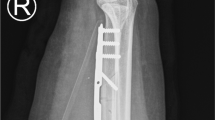Abstract
Introduction
Distal radius mal-unions often cause radius shortening and ulnar impaction syndrome. The modern treatments of ulnar impaction syndrome following distal radius mal-union are ulnar shortening osteotomy (USO) and distal radius lengthening osteotomy (DRLO). However, there are few studies to compare long-term outcomes of these two treatments. This study compares isolated USO to DRLO for the treatment of ulnar impaction syndrome following distal radius mal-union.
Materials and Methods
We retrospectively reviewed 68 patients with extra-articular distal radius mal-unions treated by isolated USO in 36 patients and DRLO in 32 patients. Pain visual analog scale (VAS), wrist motion, grip strength, radiographic parameters including sigmoid inclination, DASH score, and perioperative complications were analyzed. Mean follow-up was 62.6 months.
Results
The postoperative VAS scores for pain on exertion were less in the DRLO group than the USO group (1.2 vs. 2.8, p = 0.02). The DASH scores were 16.7 and 29.8 in the DRLO and USO groups, respectively (p = 0.02). The reduction of pain and improvement of function showed significantly better in the DRLO group. The mean operative time was shorter in the USO group. Most of the sigmoid inclinations were changed in DRLO. There were two re-operations following USO for painful nonunion and two patients had subsequent DRUJ osteoarthritis at the last follow-up.
Conclusion
Although both treatments improved range of motion, grip strength, and VAS for pain, DRLO was found in better reduction of pain and improvement of function. USO is a simpler procedure with a shorter operative time but it has an increased potential to cause subsequent osteoarthritis of the DRUJ as its incongruity of DRUJ after USO especially in reverted inclination. DRLO can be a preferred method for treating USWP in relevant distal radial mal-union.


Similar content being viewed by others
Change history
02 December 2021
A Correction to this paper has been published: https://doi.org/10.1007/s00402-021-04271-7
References
Baek GH, Lee HJ, Gong HS et al (2011) Long-term outcomes of ulnar shortening osteotomy for idiopathic ulnar impaction syndrome: at least 5-years follow-up. Clin Orthop Surg 3(4):295–301
Barbaric K, Rujevcan G, Labas M, Delimar D, Bicanic G (2015) Ulnar shortening osteotomy after distal radius fracture malunion: review of literature. Open Orthop J 9:98–106
Delclaux S, Trang Pham TT, Bonnevialle N et al (2016) Distal radius fracture malunion: Importance of managing injuries of the distal radio-ulnar joint. Orthop Traumatol Surg Res 102(3):327–332
Evans BT, Jupiter JB (2019) Best approaches in distal radius fracture malunions. Curr Rev Musculoskelet Med 12(2):198–203
Gilbert F, Jakubietz RG, Meffert RH, Jakubietz MG (2018) Does Distal Radio-ulnar Joint Configuration Affect Postoperative Functional Results after Ulnar Shortening Osteotomy? Plast Reconstr Surg Glob Open 6(4):1760
Hassan S, Shafafy R, Mohan A, Magnussen P (2019) Solitary ulnar shortening osteotomy for malunion of distal radius fractures: experience of a centre in the UK and review of the literature. Ann R Coll Surg Engl 101(3):203–207
Hudak PL, Amadio PC, Bombardier C (1996) Development of an upper extremity outcome measure: the DASH (disabilities of the arm, shoulder and hand) [corrected].The Upper Extremity Collaborative Group (UECG). Am J Ind Med 29(6):602–608
Kamal RN, Leversedge FJ (2014) Ulnar shortening osteotomy for distal radius malunion. J Wrist Surg 3(3):181–186
Katt B, Seigerman D, Lutsky K, Beredjiklian P (2020) Distal radius malunion. J Hand Surg Am 45(5):433–442
Kim JK, Kim DJ, Yun Y (2016) Natural history and factors associated with ulnar-sided wrist pain in distal radial fractures treated by plate fixation. J Hand Surg (Eur Vol) 41(7):727–731
Löw S, Mühldorfer-Fodor M, Pillukat T, Prommersberger KJ, van Schoonhoven J (2014) Ulnar shortening osteotomy for malunited distal radius fractures: results of a 7-year follow-up with special regard to the grade of radial displacement and post-operative ulnar variance. Arch Orthop Trauma Surg 134(1):131–137
Mulders MA, d’Ailly PN, Cleffken BI, Schep NW (2017) Corrective osteotomy is an effective method of treating distal radius malunions with good long-term functional results. Injury 48(3):731–737
Oskam J, Kingma J, Klasen HJ (1993) Ulnar-shortening osteotomy after fracture of the distal radius. Arch Orthop Trauma Surg 112(4):198–200
Ring D (2005) Treatment of the neglected distal radius fracture. Clin Orthop Relat Res 431:85–92
Srinivasan RC, Jain D, Richard MJ, Leversedge FJ, Mithani SK, Ruch DS (2013) Isolated ulnar shortening osteotomy for the treatment of extra-articular distal radius malunion. J Hand Surg Am 38(6):1106–1110
Tolat AR, Stanley JK, Trail IA (1996) A cadaveric study of the anatomy and stability of the distal radioulnar joint in the coronal and transverse planes. J Hand Surg Br 21(5):587–594
Funding
The authors received no financial support for the research, authorship, and/or publication of this article.
Author information
Authors and Affiliations
Corresponding author
Ethics declarations
Conflict of interest
The authors declare no potential conflicts of interest with respect to the research, authorship, and/or publication of this article. Each author certifies that he or she has no commercial associations (e.g., consultancies, stock ownership, equity interest, patent/licensing arrangements, etc.) that might pose a conflict of interest in connection with the submitted article.
Ethical approval
Taipei Veterans General Hospital approved the human protocol for this investigation, and each author certifies that all investigations were conducted in conformity with ethical principles of research. The study was done at Taipei Veterans General Hospital, Taipei, Taiwan.
Additional information
Publisher's Note
Springer Nature remains neutral with regard to jurisdictional claims in published maps and institutional affiliations.
The original online version of this article was revised: Affiliation details of Yi-Chou Chen and Yi-Chao Huang were incorrect.
Rights and permissions
About this article
Cite this article
Ma, HH., Chen, YC., Huang, HK. et al. Comparing radial lengthening osteotomy with ulnar shortening osteotomy to treat ulnar impaction syndrome after distal radius fracture malunion. Arch Orthop Trauma Surg 142, 525–531 (2022). https://doi.org/10.1007/s00402-021-04247-7
Received:
Accepted:
Published:
Issue Date:
DOI: https://doi.org/10.1007/s00402-021-04247-7




